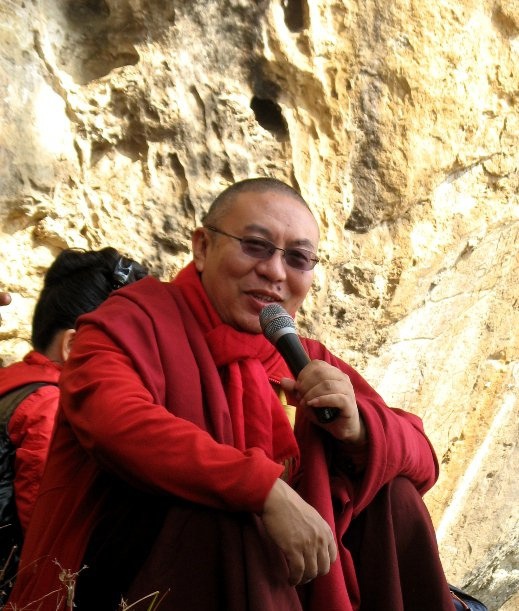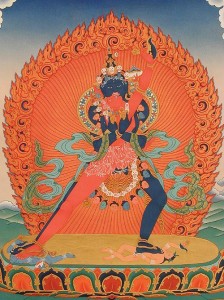This excellent series of questions and answers with Shangpa Rinpoche was posted today on the Shangpa online blog:
Q: Some dharma practitioners face life challenges such as being jobless and experiencing business downfall which affect their daily life as a practitioner. In this situation, which should come first? Dharma or business?
A: Firstly, you should try to understand what is Dharma or at least to understand the Dharma as a mental development and how to place the mind correctly with awareness and wisdom. With this understanding, one’s business or work will not be hindered and instead one will succeed greatly. It is said by the Buddha that the nature of all phenomena arises from the mind and so the mind is the primary and initiator of everything. If our mind is pure or clean from defilements, whether one talks or does anything, one will gain blissfulness. If our mind is pure and clear, then you will be able to perform every piece of work well and that includes your business, daily activities and handling of people.
If you think Dharma is merely going to a temple, sitting cross-legged, chanting and counting with a rosary, then that may affect your job or business sometimes. Good physical gestures should naturally arise from pure mental inspiration and in this way you can complete a good practice. Dharma should be the leading path for us and in showing the ultimate and relative Truth.
So in this way Dharma should come first amongst all activities and it can be the cause of every success too.
Q: When one is being overwhelmed with great anger, it is extremely difficult to be aware and mindful of one’s present actions. During these moments, how does one control the mind and stop oneself from creating negative thoughts and actions that are based on anger?
A: There is no formula that can be instantly applied with immediate and effortless results. Anger is part of our emotions. When anger overflows, it shows how strong and aggressive emotions can be. Sometimes, it is so strong that we are unable to stop it when it arises. So we must know that there is a root cause of all these emotions in our mind. Such root cause can be regarded as an obstruction to see the reality. That is ignorance and we need to apply wisdom to counteract.
For ordinary people, the gradual improvement of handling emotion is to first recognize the emotion and it’s defects. Secondly, one should try to disperse it with the application of an antidote. Thirdly, knowing the nature of emotion as emptiness cuts off the root of emotion.
To do this, you need to explore the teachings of the Buddha and try to contemplate, meditate, as well as practice purification of sins and accumulation of merit.
Q: What is the most effective method for ordinary practitioners to be constantly reminded to not commit the five poisons (desire, anger, ignorance, pride and jealousy) when we are living in this samsaric world?
A: Mindfulness is the most important key for all practitioners. Generally, we know that the five poisons are harmful. However, most of the time we are not aware that they have arisen and that the poison has already been transmitted to ourselves. Only when we experience the results of the poison, then we realized that it is too late. If we are constantly mindful of the arising of the poison, we won’t embrace it but keep far away from it as such poisons are far more destructive than ordinary poison. So good practitioners always use awareness and mindfulness to guard against the defilements and with that, the chances of defilement disturbance are reduced and eventually it can be stopped.
Q: Many people who lack knowledge in Vajrayana Buddhism seems to have false interpretations towards tantric images. What is the philosophy or significance of these images or symbols, (for example, the sexual union depiction of the ‘yabyum’)? How do we resolve others’ misunderstanding towards Vajrayana Buddhism?
A: Such misunderstanding has arisen since the existence of these images. Vajrayana approach is rather different from others so when your mind is fixed on one method, it is natural that you cannot accept other ways that appear different from your beliefs. If the person is not set in his ways and try to explore and understand the truth, then such misunderstanding may not happen. Vajrayana uses emotion to disperse emotion, just like using poison to cure poisonous effect. That is the path shown by the Buddha in most tantric teachings. There are many symbolic objects that reflect emotions but when you dismantle the tie of attachment towards certain emotion, then that emotion may not sustain as emotion but rather a form of cognition and that is wisdom itself. So we should firstly understand what is emotion outwardly, followed by the nature of emotion inwardly, and finally establish the seal of non-attachment or great expanse of emptiness and then transform it into wisdom which ultimately results in enlightenment.
Vajrayana is a very individual practice and traditionally it is not exposed to everyone. Practitioners must have very clear minds to practise and understand the instructions given by the guru in order to succeed in their practice within a short time. Today, Vajrayana practice is very common and sometimes it sadly abused as a commercial purpose. So these days, it is rather difficult to check or see if a person is suitable for Vajrayana practise or how well one has practiced.
We may not be able to resolve the misunderstandings that people may have towards such yabyum Buddhist symbols. Even in early times, great masters like Nagarjuna and many other gurus such as the Buddha himself could not remove this misunderstanding from the people completely. We ourselves have not awakened totally from confusion and so how can we lead others onto the correct path of Vajrayana? There is a Tibetan saying that if the blind leads the blind, then at the end is a tumble or a fall. So the first and most important thing for us to do is to explore the teaching and apply it onto ourselves so that we may develop the ability to lead others to the right path.
Other posts which may be of interest :
Tags: Shangpa Rinpoche





 Follow
Follow